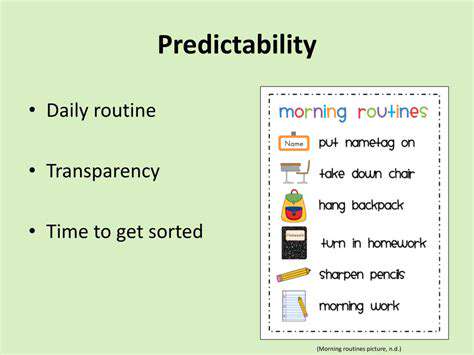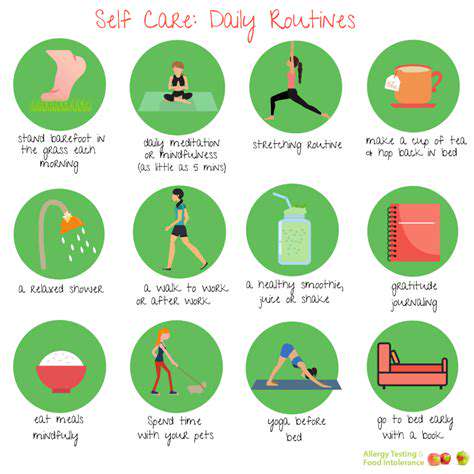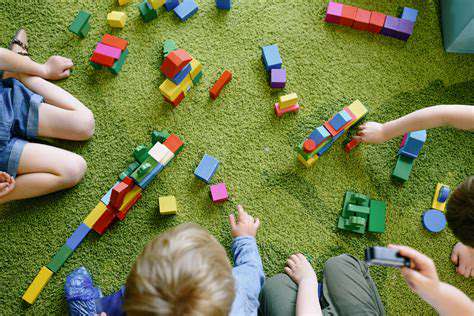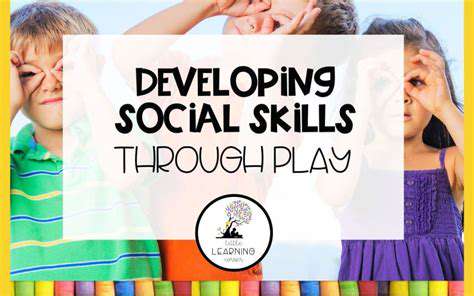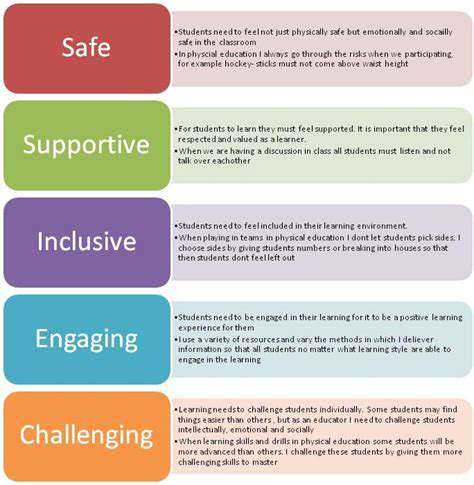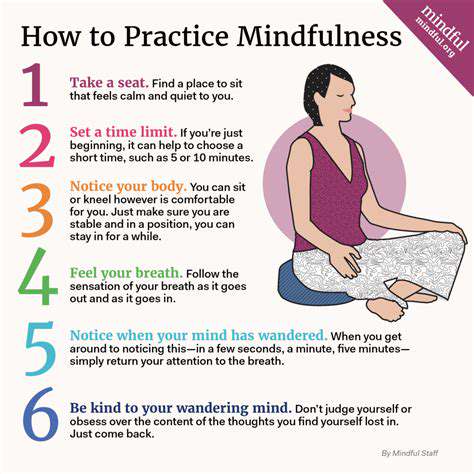Addressing Bedtime Anxiety With Soothing Practices
Creating a Relaxing Bedtime Routine
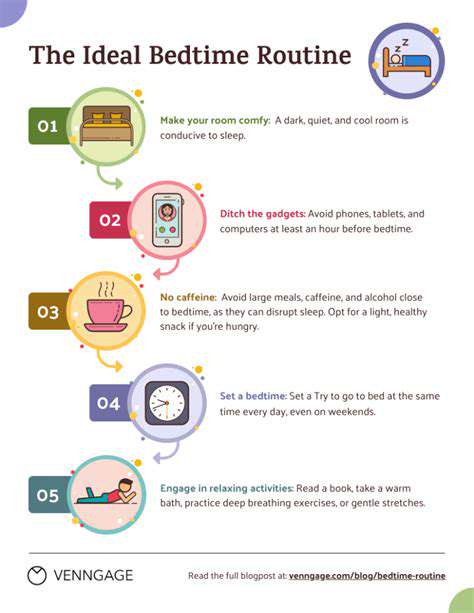
Establishing a Consistent Schedule
A consistent bedtime routine is crucial for regulating your body's natural sleep-wake cycle, also known as the circadian rhythm. Establishing a regular sleep schedule, even on weekends, helps your body anticipate sleep and promotes better quality sleep. This means going to bed and waking up around the same time each day, fostering a predictable sleep-wake pattern that your body will naturally adapt to.
Consistency in your bedtime routine signals to your body that it's time to wind down and prepare for sleep. This predictability is key to improving sleep quality and duration, allowing you to wake up feeling refreshed and energized. Making small adjustments like consistently using the same calming bedtime routine can have significant positive effects on your overall well-being.
Creating a Relaxing Atmosphere
Creating a calming and peaceful environment in your bedroom is essential for promoting relaxation before bed. Dim the lights, use soft, calming music, or try gentle aromatherapy with lavender or chamomile essential oils. These sensory cues signal to your brain that it's time to unwind and prepare for sleep.
A comfortable temperature, ideally cool, is also important. A dark, quiet, and cool bedroom environment can significantly improve sleep quality. Investing in blackout curtains or an eye mask, earplugs, or a white noise machine can help block out distracting light and sounds, creating an optimal sleep environment.
Incorporating Relaxing Activities
Engaging in calming activities before bed can help transition your mind and body from a state of alertness to a state of relaxation. Reading a book, listening to calming music, or taking a warm bath can help you unwind and prepare for sleep. These activities can effectively distract you from stressful thoughts and worries, promoting a more peaceful mental state.
Avoid screen time before bed, as the blue light emitted from electronic devices can interfere with your body's natural melatonin production, which is crucial for regulating sleep. Consider using a dedicated time before bed for relaxing activities that promote a more peaceful state of mind.
Nourishing Your Body for Sleep
What you eat and drink before bed can significantly impact your sleep quality. Avoid heavy meals or large amounts of caffeine or alcohol close to bedtime. These substances can disrupt your sleep cycle and lead to restlessness and difficulty falling asleep.
Light snacks like a small bowl of oatmeal or a glass of warm milk can help promote relaxation and potentially aid sleep. However, ensure that you don't consume heavy foods or drinks right before going to sleep. Adjusting your evening meals and snacks can make a substantial difference in promoting restful sleep.
The Power of Relaxation Techniques
Deep Breathing Exercises
Deep breathing exercises are a cornerstone of relaxation techniques, and they're incredibly effective for managing anxiety before bed. By focusing on slow, deliberate breaths, you can calm your nervous system and reduce feelings of overwhelm. Incorporating these exercises into your nightly routine can help to transition your mind and body from a state of heightened alertness to a state of peaceful readiness for sleep. Practicing deep, abdominal breaths, where you feel your stomach rise and fall with each inhale and exhale, is particularly beneficial. This type of breathing can quiet the racing thoughts that often accompany bedtime anxiety.
There are many variations on deep breathing techniques, from simple box breathing to more complex methods. Experiment with different approaches to find what works best for you. The key is consistency and focusing on the sensation of the breath as it enters and leaves your body.
Progressive Muscle Relaxation
Progressive muscle relaxation involves systematically tensing and releasing different muscle groups in your body. This technique helps to identify and release physical tension that often accompanies anxiety. Starting with your toes and working your way up, tense each muscle group for a few seconds, focusing on the sensation of tightness. Then, slowly release the tension, allowing the muscles to relax completely. This process helps to create a sense of physical calm, which can then extend to your mind.
Progressive muscle relaxation takes practice, but the benefits are significant. By consciously relaxing your body, you can create a more receptive state for sleep and reduce the physical manifestations of anxiety.
Mindfulness Meditation
Mindfulness meditation involves focusing on the present moment without judgment. This practice helps to quiet the mental chatter that often contributes to bedtime anxiety. By bringing your attention to your breath, bodily sensations, or the sounds around you, you can detach from worries about the past or anxieties about the future.
Regular mindfulness meditation practice can cultivate a sense of inner peace and acceptance, making it easier to navigate the challenges of bedtime anxiety. It's important to find a quiet space where you can sit comfortably and focus on your breath without distractions.
Guided Imagery
Guided imagery involves creating vivid mental images to promote relaxation. You can picture yourself in a peaceful setting, such as a serene beach or a cozy cabin. Focus on the details of the scene – the sights, sounds, smells, and textures – to fully immerse yourself in the image and allow your mind to drift away from anxious thoughts.
Guided imagery can be particularly helpful for bedtime anxiety, as it can help to create a sense of calm and escape from racing thoughts. Many guided imagery recordings are available online and in apps, making it easy to access these beneficial tools.
Yoga and Stretching
Gentle yoga poses and stretching routines can be incredibly effective in reducing muscle tension and promoting relaxation before bed. These practices can help release physical tension that often accompanies anxiety, making it easier to unwind and prepare for sleep. Incorporating a few simple poses, such as child's pose or gentle spinal twists, can effectively ease any physical discomfort and bring a sense of calm.
Yoga and stretching are not only beneficial for physical relaxation but also encourage a sense of mindfulness, contributing to a more peaceful and calm state of mind. Choosing poses that are gentle and restorative is crucial for this practice before sleep.
Journaling
Journaling can be a powerful tool for managing bedtime anxiety. Writing down your thoughts and feelings can help you process them and release them from your mind, preventing them from lingering and exacerbating anxiety. By putting your concerns into words, you can gain a sense of control and clarity over those worries.
Expressing your anxieties in a journal can be cathartic and help you to understand the underlying causes of your bedtime anxiety. This self-reflection can empower you to identify coping mechanisms and strategies to effectively manage these anxieties.
Establishing a Relaxing Bedtime Routine
A consistent bedtime routine can play a significant role in preparing your body and mind for sleep. Establishing a calming routine helps signal to your body that it's time to wind down. Activities such as taking a warm bath, reading a book, or listening to calming music can help transition you from a state of activity to a state of relaxation.
A consistent bedtime routine is crucial for regulating your body's natural sleep-wake cycle. By creating a predictable and relaxing nightly ritual, you can create a stronger association between these activities and sleep, making it easier to fall asleep and stay asleep.
Utilizing Comfort Items and Safe Spaces
Creating a Consistent Routine
Establishing a predictable bedtime routine is crucial for reducing bedtime anxiety. A consistent sequence of activities signals to the body and mind that it's time to wind down. This could include a warm bath, reading a book, listening to calming music, or engaging in gentle stretches. Consistency helps regulate the body's natural sleep-wake cycle, making it easier to fall asleep and stay asleep throughout the night.
The routine should be tailored to the individual child's needs and preferences, but it should be followed consistently, every night. This predictability reduces uncertainty and creates a sense of security, which is particularly important for children experiencing anxiety.
Identifying and Addressing Triggers
Understanding what might be causing bedtime anxiety is a crucial first step in addressing it. Is it a fear of the dark, a worry about missing something, or perhaps a concern about a particular event or person? Identifying the trigger allows parents to address the specific cause of the anxiety, either by providing reassurance, addressing the underlying concern, or exploring coping mechanisms.
Sometimes, the trigger isn't immediately obvious. Taking the time to observe the child's behavior and talk to them about their feelings can help uncover the root cause of their anxiety, enabling parents to offer support and create a more comfortable environment.
Utilizing Comfort Items
Comfort items, such as a favorite blanket or stuffed animal, can provide a sense of security and comfort for children during bedtime. These items serve as tangible reminders of familiar and comforting experiences, helping children feel grounded and safe in unfamiliar or anxious situations. They offer a sense of familiarity and security, which is particularly beneficial for children who might feel overwhelmed or anxious.
Encouraging the child to select their own comfort item can empower them and increase their attachment to it. It's important to respect the child's choice and allow them to use this item as a source of comfort throughout the bedtime routine, and even during the night if needed.
Designing Safe Spaces
Creating a safe and calming bedroom environment can significantly reduce bedtime anxiety. Dim lighting, soft colors, and calming décor can create a peaceful atmosphere conducive to relaxation and sleep. A quiet and well-organized space promotes a sense of order and control, which is particularly important for children who may struggle with anxieties.
Ensuring the room is free from any potential distractions or triggers can also contribute to a more peaceful sleep environment. Eliminating visual or auditory stressors can help children relax and focus on falling asleep.
Incorporating Relaxation Techniques
Teaching relaxation techniques, such as deep breathing exercises or guided imagery, can equip children with coping mechanisms to manage anxiety. These techniques help to calm the nervous system and reduce feelings of fear or overwhelm. Practicing these techniques regularly can help children develop self-soothing skills that they can utilize independently.
These techniques can be incorporated into the bedtime routine as a way to transition from wakefulness to sleep. They can also be used as needed if the child experiences anxiety throughout the night.
Seeking Professional Guidance
If bedtime anxiety persists or significantly impacts a child's well-being, seeking professional guidance from a pediatrician or child psychologist is crucial. These professionals can offer tailored strategies and support to address the specific needs of the child and provide guidance for parents. A professional assessment can help determine the root cause of the anxiety and develop an appropriate intervention plan.
A professional can help identify any underlying issues, develop personalized strategies, and provide ongoing support as needed. They can also offer guidance to parents on how to best support their child's emotional well-being during this challenging time.

